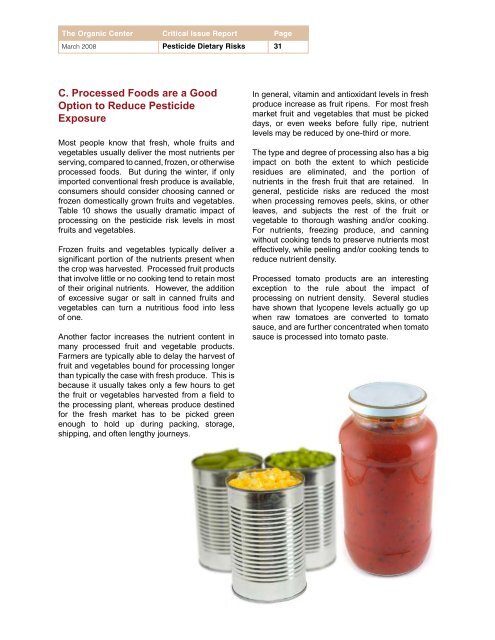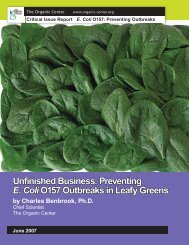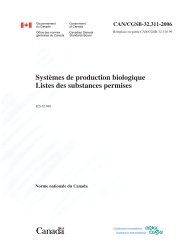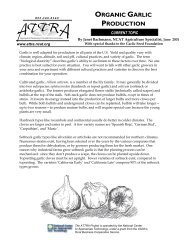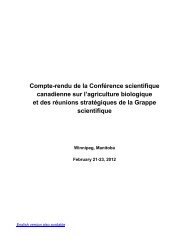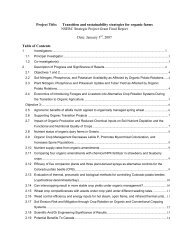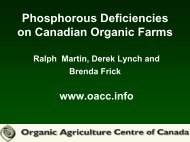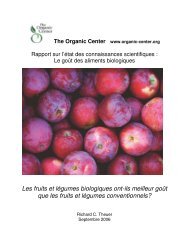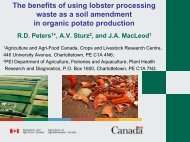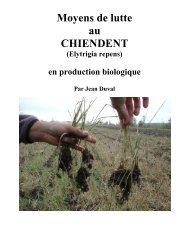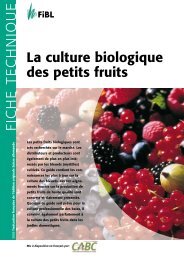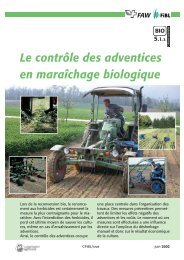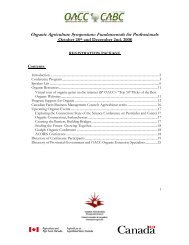The Organic Option - Centre d'agriculture biologique du Canada
The Organic Option - Centre d'agriculture biologique du Canada
The Organic Option - Centre d'agriculture biologique du Canada
Create successful ePaper yourself
Turn your PDF publications into a flip-book with our unique Google optimized e-Paper software.
<strong>The</strong> <strong>Organic</strong> Center Critical Issue Report Page<br />
March 2008 Pesticide Dietary Risks 31<br />
C. Processed Foods are a Good<br />
<strong>Option</strong> to Re<strong>du</strong>ce Pesticide<br />
Exposure<br />
Most people know that fresh, whole fruits and<br />
vegetables usually deliver the most nutrients per<br />
serving, compared to canned, frozen, or otherwise<br />
processed foods. But <strong>du</strong>ring the winter, if only<br />
imported conventional fresh pro<strong>du</strong>ce is available,<br />
consumers should consider choosing canned or<br />
frozen domestically grown fruits and vegetables.<br />
Table 10 shows the usually dramatic impact of<br />
processing on the pesticide risk levels in most<br />
fruits and vegetables.<br />
Frozen fruits and vegetables typically deliver a<br />
significant portion of the nutrients present when<br />
the crop was harvested. Processed fruit pro<strong>du</strong>cts<br />
that involve little or no cooking tend to retain most<br />
of their original nutrients. However, the addition<br />
of excessive sugar or salt in canned fruits and<br />
vegetables can turn a nutritious food into less<br />
of one.<br />
Another factor increases the nutrient content in<br />
many processed fruit and vegetable pro<strong>du</strong>cts.<br />
Farmers are typically able to delay the harvest of<br />
fruit and vegetables bound for processing longer<br />
than typically the case with fresh pro<strong>du</strong>ce. This is<br />
because it usually takes only a few hours to get<br />
the fruit or vegetables harvested from a field to<br />
the processing plant, whereas pro<strong>du</strong>ce destined<br />
for the fresh market has to be picked green<br />
enough to hold up <strong>du</strong>ring packing, storage,<br />
shipping, and often lengthy journeys.<br />
In general, vitamin and antioxidant levels in fresh<br />
pro<strong>du</strong>ce increase as fruit ripens. For most fresh<br />
market fruit and vegetables that must be picked<br />
days, or even weeks before fully ripe, nutrient<br />
levels may be re<strong>du</strong>ced by one-third or more.<br />
<strong>The</strong> type and degree of processing also has a big<br />
impact on both the extent to which pesticide<br />
resi<strong>du</strong>es are eliminated, and the portion of<br />
nutrients in the fresh fruit that are retained. In<br />
general, pesticide risks are re<strong>du</strong>ced the most<br />
when processing removes peels, skins, or other<br />
leaves, and subjects the rest of the fruit or<br />
vegetable to thorough washing and/or cooking.<br />
For nutrients, freezing pro<strong>du</strong>ce, and canning<br />
without cooking tends to preserve nutrients most<br />
effectively, while peeling and/or cooking tends to<br />
re<strong>du</strong>ce nutrient density.<br />
Processed tomato pro<strong>du</strong>cts are an interesting<br />
exception to the rule about the impact of<br />
processing on nutrient density. Several studies<br />
have shown that lycopene levels actually go up<br />
when raw tomatoes are converted to tomato<br />
sauce, and are further concentrated when tomato<br />
sauce is processed into tomato paste.


